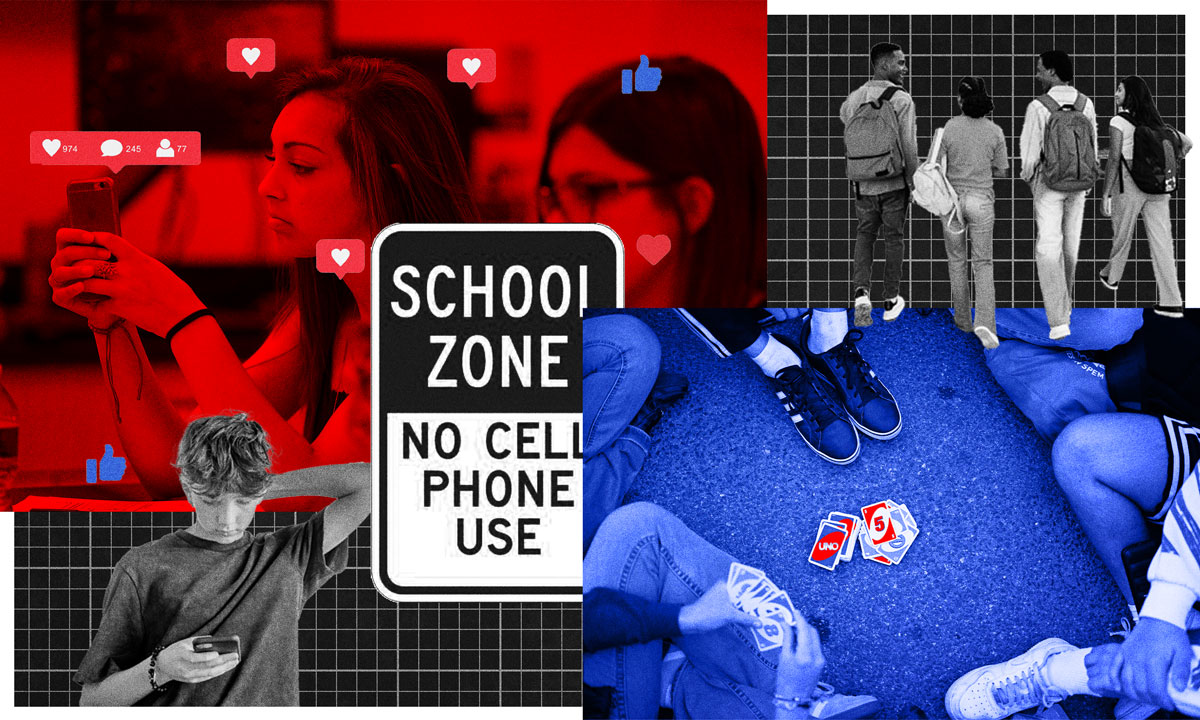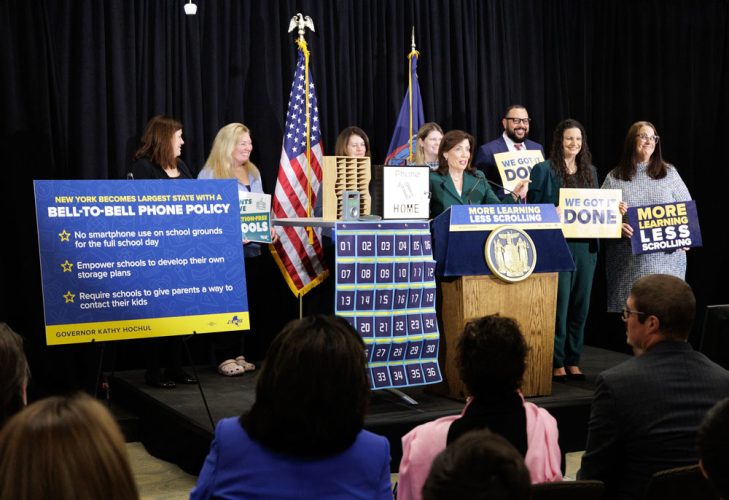Support for Phone Bans in Schools Is Growing, but Is It Enough to Help Kids?
New York will implement one of the strictest bans on school technologies, but experts are split on if it will help mental health challenges.

Get stories like this delivered straight to your inbox. Sign up for The 74 Newsletter
New York City educators Vincent Corletta and Meghan Leston both chuckled when they were asked what it was like to teach in schools without cellphone restrictions.
Their reactions were followed by a sigh of relief at the next question: How has life changed since your schools implemented phone bans?
A huge change, they both said, in their classrooms and throughout their schools. Where once TikTok videos were being filmed in school hallways and Instagram Reels watched during instruction, teachers now feel like they “actually have the whole attention of the class,” Corletta said.
“It’s like night and day. It’s so different,” said Corletta, comparing his experience as an English language arts teacher at MS 137 in South Ozone Park Queens, which began using magnetically locked phone pouches about five years ago, to his previous experience at a Bronx school with no restrictions. “I don’t touch [the phones]. I don’t hold them. I don’t see them, I don’t do anything like that and it’s really really nice.”
Once silent cafeterias now have kids yelling, gossiping and playing cards – a refreshing sight for many educators like Corletta and Leston, who teach in middle and high schools respectively. Lunchtime, for many school leaders, used to feel like phone time.
But now, “students are playing Uno again in the cafeteria,” said New York City Department of Education Deputy Chancellor Danika Rux in an interview with The 74.
New York City schools have had a long history of phone restriction policies, with an outright ban in the early 2000s that was reversed about 10 years later. Individual schools, like the ones where Corletta and Leston teach, have had the freedom to implement their own restrictions.
That will change again in the new academic year as all schools in New York state will implement a bell-to-bell ban — one of the strictest among dozens of other states that have passed similar legislation — barring students from access to personal devices that can connect to the internet for the entire school day. Schools will be required to provide storage for the devices.

But with such new policies, many being implemented for the first time this school year or in effect for less than two years, no one knows what the perfect model looks like.
Researchers are moving cautiously as they grapple with uncertainty about the effectiveness of in-school phone bans on mental health. Data yields mixed results — and there’s growing a sentiment that more has to be done outside of schools to get kids off their phones and back into the world.
A recent Pew Research survey found that nearly three quarters of Americans support restrictive phone use in schools, up six percentage points since last year — but many are also unsure how far the bans should go. About 44% of respondents supported all day bans, with others split on whether students should have access to their phones between classes or at lunch.
“We do have some emerging evidence from the research that shows that phone bans can have pretty substantial positive effects,” said Katie Rybakova, an associate professor and chair at the Lunder School of Education at Thomas College in Waterville, Maine.
But studies are limited and “really small from the researcher lens.” Inconsistencies in how bans are implemented from state to state, district to district, school to school and classroom to classroom make it hard to measure, she said.
“You can’t compare a rural district in Alabama to a suburban district in New York,” Rybakova said. “It’s going to look very different, depending on the place and space, and the students that you’re working with, the teachers, how it’s monitored and what kind of accountability measures are in place.”
With the ban in New York about to take effect, some schools have had to scrap policies that have worked for them to now adhere to new legislation, while others are implementing digital bans for the first time.
“Implementation is daunting,” Leston said. “When I heard of the [state] ban, I was like, ‘Oh, that’s great!’ My school already had one, but then I thought about it for a minute, and I said, ‘Oh, this is going to be a big deal for a lot of schools, especially large comprehensive high schools.’ … It’s going to be a very hard norm to create cellphone free schools.”
Growing support across the country
Annette Campbell Anderson, an associate professor at John Hopkins School of Education, said increasing legislation calling for cellphone bans in schools nationwide has come from a “perfect storm” of push and pull between district leaders, teachers and parents.
The COVID-19 pandemic and remote learning pushed students into an unprecedented dependency on technology use for school, socialization and entertainment.
“There was this overwhelming desire for kids to get their education online, and so because schools were closed, … everyone thought, ‘Well, we’ve got these phones. We’ve got this access to technology. Why don’t we use that?’ ” Anderson said.
At the same time, parents also had unparalleled access to the classroom during the pandemic where they got to see what and how their children were being educated. When students returned to their physical campuses, parents wanted to “keep a bird’s eye view on what was happening in school,” and tried to remain in close communication with their children, Anderson said, also acknowledging growing fears of school shootings and school safety.
The result? “We pushed the phones into the hands of our young people,” Anderson said.
In schools, students remained mentally checked out and educators grew frustrated.
“Before we instituted a ban, kids were preoccupied with their cellphones. They were on their social media. … They were creating TikToks in the hallway,” Leston said. “It contributed to conflict in the building. Kids couldn’t communicate with each other. They were distracted in the classroom.”
Mental health issues began to spike, hitting a breaking point for everyone.
“All these things were coalescing into this perfect storm of a moment,” Anderson said. “What you have [now] is a bunch of people who have the instinct that we’ve gone too far.”
Extent of cell bans triggers split response
Around 31 states across the country have implemented or recommended some type of school-based technology ban, according to tracking from EdWeek.
There’s some argument that New York’s policy may be too restrictive and left some superintendents across the state feeling like their hands were tied when their schools had bans that were working.
“We’ve seen districts which had adopted very thoughtful policies, and in some cases, with student engagement, they were accepted,” said Robert Lowry, deputy director for advocacy, research and communications for the New York State Council of School Superintendents. “They seemed to be working well, so [the new legislation] was a point of contention.”
One New York district, for example, allowed students access to personal devices in certain areas of their schools buildings and with permission, which was popular with students, parents and educators, Lowry said.
But with the state ban going into effect, that policy will quickly have to be revised with limited time and community input.
“If you want to try and engage parents, teachers and others in developing a policy – hopefully building a consensus – summer is not the best time,” Lowry said.
New York State allocated $13.5 million in its latest budget toward implementation, which is expected to help purchase storage options. New York City has also added an extra $25 million to its budget to help support the shift for the upcoming school year.
“We’ve given them templates of what a policy could look like, so that they can customize for their school community. We’ve given them sample communication to families,” Rux said.
More work to be done, in and out of school buildings
For researchers, cellphone bans raise concerns if parents and educators are going to see the outcomes they’re hoping for — with many researchers saying there needs to be more proactive measures outside of school to see an improvement in children’s mental health.
“I feel like the bans don’t go far enough, and if we just check the box to say we’ve banned it in school, we’ve basically pushed this responsibility on to teachers and administrators to be responsible for this and then we’ve also said that we don’t care what happens after school,” John Hopkins’ Anderson said.
Researchers suggested reform may begin with better educating parents on the effects of screen-time and a push toward better modeling of behavior, but it may also be a call for more legislative action on social media use as a whole.
“What we really need is a digital code of conduct for our young people to understand what they should be doing,” Anderson said. “We’ve got warnings on nicotine, we’ve got warnings on alcohol, but the device that’s actually in a kid’s hand more times than not – we don’t have any guardrails around any of that.”
Get stories like these delivered straight to your inbox. Sign up for The 74 Newsletter

;)
